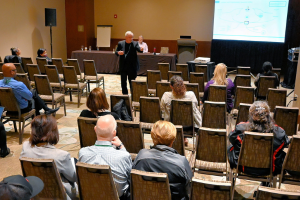
By Michelle Mott, AACRAO Consultant, Innovative Credentials Project Manager, Live from SEM 2024
The student population in higher education is diversifying, with an increasing number of non-traditional students, including adult learners, transfer students, and those pursuing skills-based education. This change is altering the types of credentials students earn and how they are moving through the educational system. Institutions are grappling with the complexities of transfer processes, systemic weaknesses, and the demand for more flexible, skills-based learning opportunities. This shift is driving increased competition among institutions, which are vying to attract a more diverse, skilled student body with robust, innovative offerings.
Additionally, the public perception of higher education is evolving. Institutions are under pressure to demonstrate the tangible value of their programs with rising tuition costs and a growing focus on workforce readiness. Digital credentials such as microcredentials, badges, Comprehensive Learner Records (CLRs), and Learner and Employment Records (LERs), in particular, are emerging as key tools in this transformation, helping institutions showcase the real-world competencies of their students.
AACRAO’s Dr. Mike Simmons, Associate Executive Director of Business Development & Strategic Partnerships, and Mark McConahay, Senior Consultant and Innovative Credential Coordinator, hosted a pair of sessions, "Leveraging Digital Credentials, Learning and Employment Records (LERs), and Microcredentials to Transform College Recruiting and Admissions" and "Empowering and Enhancing Enrollment through Innovative Credentials - Infuse: Empowering Institutions, Enabling Learners," at the recent SEM 2024 Conference in Boston. Here you’ll find session highlights that delve into:
The advantages of digital credentials, specifically LERs, for admissions, retention, and transfer
New innovations to reduce barriers to digital credential adoption
The benefits of infrastructure for learners and institutions
Reimagining Recruitment and Admissions
Institutions increasingly turn to digital credentials to reshape their recruitment and admissions processes. Universities like Georgia Tech, the University of California, Berkeley, and Syracuse already use digital credentials to assess applicants holistically. By incorporating digital badges, microcredentials, and LERs, institutions can create richer, more accurate student profiles that go beyond traditional metrics like standardized test scores and GPA.
This allows for targeted outreach and personalized marketing that speaks to the specific competencies students bring to the table. It also helps institutions attract a diverse student body, including those who may have been overlooked by traditional recruiting methods. By recognizing skills-based credentials, institutions can engage a broader range of learners, especially those in non-traditional pathways. While the number of institutions incorporating innovative credentials into their recruiting and admissions processes remains small, we believe there will be increasing opportunity and demand for this approach.
LERs for Streamlining Admissions, Improving Retention, and Supporting Transfer Credit
Digital credentials offer significant advantages for improving both the admissions process and student retention efforts. LERs provide a more comprehensive, skills-based view of a learner's capabilities, facilitating a holistic assessment that captures achievements from across an individual’s academic and extracurricular experiences. This holistic approach allows institutions to streamline evaluation processes and make more informed decisions during admissions, addressing many of the challenges traditional systems pose.
On the retention front, LERs help align learner engagement with career goals, ensuring that learners stay on track academically and professionally. Institutions can use these records to personalize advising, offer targeted mentorship, and track progress in real-time. This connection between learning and workforce readiness can enhance student motivation and keep them engaged throughout their academic journey.
Moreover, digital credentials can support seamless transfer and credit articulation. Institutions can more easily assess prior learning, reducing friction during the transfer process and ensuring that learners can continue their education without unnecessary delays or credit loss.
The Infuse Initiative to Reduce Barriers
Despite the potential benefits, many institutions face barriers in adopting digital credentials due to technical challenges, cost, and limited infrastructure. Learners from underserved backgrounds or attending resource-constrained institutions are particularly affected, resulting in missed opportunities for skill recognition.
In an effort to bridge this gap, AACRAO is working to advance its Infuse Initiative, which would build a sustainable, public-purpose infrastructure that enables institutions to adopt digital credentials at scale. This public-purpose infrastructure should also respect the service provider's role and hopefully create a larger market by expanding the demand for digital credential exchange. This initiative seeks to meet higher education institutions where they are by converting traditional academic credentials (i.e., PDF transcripts) into open data structures suitable for participation in the digital credential ecosystem.
The Infuse Initiative aims to democratize access to digital credentials by providing foundational LERs to millions of learners as a starting point in the world of interoperable credentials. It seeks to enable institutions to affordably participate in the digital credential space, create greater value for learners, provide for more granular credentials, and position themselves as leaders in a connected, equitable, and future-ready education system.
Key objectives of the Infuse Initiative include:
Reducing the technical burden on institutions by enabling easy conversion of existing credentials, such as PDFs, into digital formats
Empowering students with control over their own credential repositories, allowing them to manage and share their records freely
Enhancing credential fidelity and learner usefulness through AI-inferred skills and standardized data, aligning with both academic and employer standards
Establishing a sustainable, public infrastructure for digital credentialing, ensuring broad access, and supporting lifelong learning
Why Infrastructure Matters
Digital credentials represent a transformative opportunity to reshape higher education by making it more learner-centric, skills-focused, and responsive to workforce needs. However, equitable access is essential for these innovations to reach their full potential. Projects like the Infuse Initiative are critical in fostering an ecosystem where institutions, especially those with limited resources, can easily adopt and benefit from digital credentialing. This evolution will help meet the demands of both today’s learners and tomorrow’s workforce.